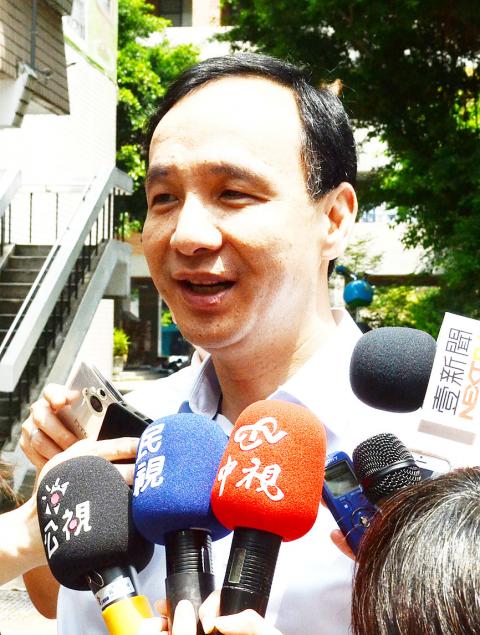The results of opinion polls on Deputy Legislative Speaker Hung Hsiu-chu (洪秀柱) are to be published today as part of the Chinese Nationalist Party’s (KMT) presidential primary, KMT Chairman Eric Chu (朱立倫) said yesterday.
Chu said everything would proceed according to the established system.
The results will be closely watched by not only the KMT’s supporters, but those of the Democratic Progressive Party, which is eager to regain the presidency it lost in 2008 by getting DPP Chairwoman Tsai Ing-wen (蔡英文) elected in January next year’s presidential race.

Photo: CNA
Hung is the only candidate to have qualified for the KMT’s presidential primary. Whether she will be nominated is to be decided by her ability to secure at least 30 percent support in the series of opinion polls conducted by three different pollsters on Friday and yesterday.
However, there have been rumors that, even if Hung passes the opinion poll test, the KMT still might not nominate her.
Over the past few days, Legislative Speaker Wang Jin-pyng (王金平) has hinted he would be interested in running for election if he is drafted by the party.
In response to rumors that the KMT might not nominate Hung and draft someone else instead, Chu said that, because the KMT is in the process of transforming into a fully democratic party, there are all kinds of rumors. The party still hopes to set up a system and act accordingly, he said.
“We respect all kinds of voices, but sometimes you should not take rumors seriously,” he said.
Many of the rumors are related to claims that Hung cannot win the national election and Wang would have a better chance of beating Tsai to succeed President Ma Ying-jeou (馬英九), who won for the KMT in 2008.
According to the ruling party’s regulations, Hung’s nomination is to be decided by the collective outcomes of the polls before confirmation by a convention of party delegates next month.
Each of the three polls was to be comprised of an “approval” survey designed to gauge respondents’ support for Hung as a candidate and a “comparative” survey testing her rating against that of the DPP’s Tsai.
Each of the three polls are required to garner 1,200 valid results in order for the results to stand.
Results from the “approval” and “comparative” components are to be assigned a 50 percent weighting toward Hung’s overall support rating assessment, and the final outcome would be taken from the average of the three polls.
If Hung fails to win at least 30 percent support in the polls, the KMT can decide not to nominate her and draft another candidate, according to party bylaws.

Former Czech Republic-based Taiwanese researcher Cheng Yu-chin (鄭宇欽) has been sentenced to seven years in prison on espionage-related charges, China’s Ministry of State Security announced yesterday. China said Cheng was a spy for Taiwan who “masqueraded as a professor” and that he was previously an assistant to former Cabinet secretary-general Cho Jung-tai (卓榮泰). President-elect William Lai (賴清德) on Wednesday last week announced Cho would be his premier when Lai is inaugurated next month. Today is China’s “National Security Education Day.” The Chinese ministry yesterday released a video online showing arrests over the past 10 years of people alleged to be

THE HAWAII FACTOR: While a 1965 opinion said an attack on Hawaii would not trigger Article 5, the text of the treaty suggests the state is covered, the report says NATO could be drawn into a conflict in the Taiwan Strait if Chinese forces attacked the US mainland or Hawaii, a NATO Defense College report published on Monday says. The report, written by James Lee, an assistant research fellow at Academia Sinica’s Institute of European and American Studies, states that under certain conditions a Taiwan contingency could trigger Article 5 of NATO, under which an attack against any member of the alliance is considered an attack against all members, necessitating a response. Article 6 of the North Atlantic Treaty specifies that an armed attack in the territory of any member in Europe,

LIKE FAMILY: People now treat dogs and cats as family members. They receive the same medical treatments and tests as humans do, a veterinary association official said The number of pet dogs and cats in Taiwan has officially outnumbered the number of human newborns last year, data from the Ministry of Agriculture’s pet registration information system showed. As of last year, Taiwan had 94,544 registered pet dogs and 137,652 pet cats, the data showed. By contrast, 135,571 babies were born last year. Demand for medical care for pet animals has also risen. As of Feb. 29, there were 5,773 veterinarians in Taiwan, 3,993 of whom were for pet animals, statistics from the Animal and Plant Health Inspection Agency showed. In 2022, the nation had 3,077 pediatricians. As of last

XINJIANG: Officials are conducting a report into amending an existing law or to enact a special law to prohibit goods using forced labor Taiwan is mulling an amendment prohibiting the importation of goods using forced labor, similar to the Uyghur Forced Labor Prevention Act (UFLPA) passed by the US Congress in 2021 that imposed limits on goods produced using forced labor in China’s Xinjiang region. A government official who wished to remain anonymous said yesterday that as the US customs law explicitly prohibits the importation of goods made using forced labor, in 2021 it passed the specialized UFLPA to limit the importation of cotton and other goods from China’s Xinjiang Uyghur region. Taiwan does not have the legal basis to prohibit the importation of goods